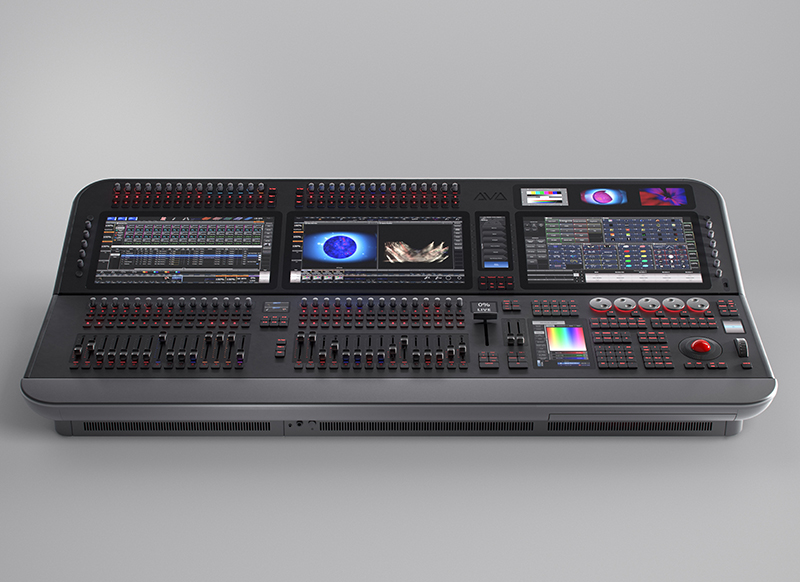
Avolites, long a leader in lighting and video control surfaces, released their latest and greatest product to date on Jan. 13 with the Diamond 9 console. This stealth-looking desk is ergonomically designed and incredibly user friendly. The Diamond 9 utilizes the same Titan software, but they have added plenty of new tricks to this feature rich desk, which is enabled with the timeline function, a key feature of Titan v15. The wooden side panels of yore are gone, and so is the old logo that Avo had incorporated since its humble beginnings in 1976. This is not your father’s Avolites, that’s for sure, but the same commitment to excellence is still keeping Avo products firmly entrenched.
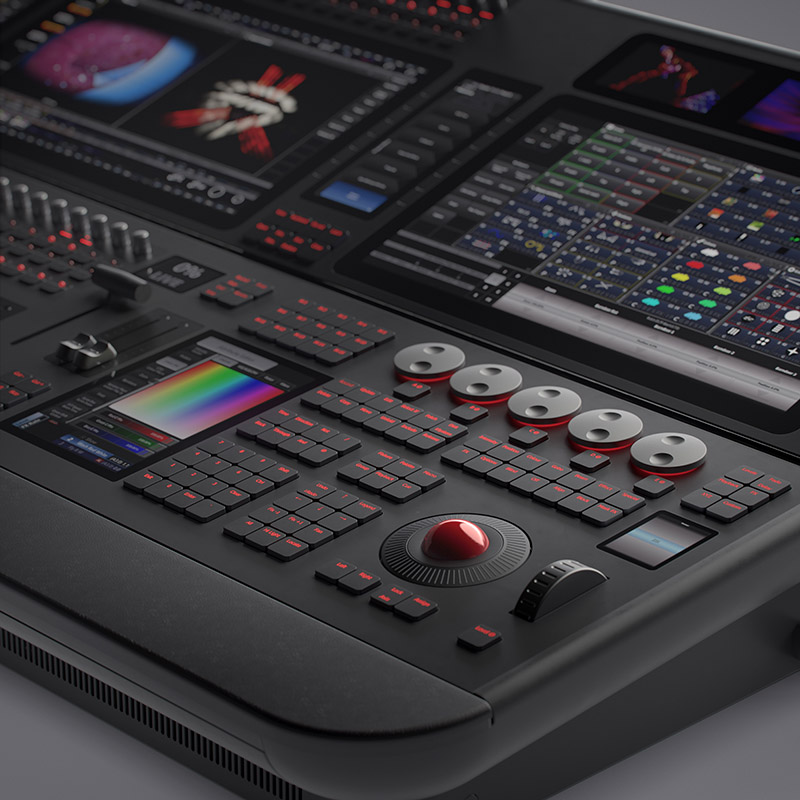
As any Avo user can tell you, the Titan software is feature-rich and is in sync with many of the same steps any programmer might follow on most desks, but is more intuitive and creativity-focused. Ease of operation, with no need to learn a new operating system nor effects engine, means that the hardware is really what has been the big selling point behind this desk, and with every new thing I check out, I realize this is probably the best large-scale console being offered on the market to anyone designing a concert. It is undoubtedly the most fun.
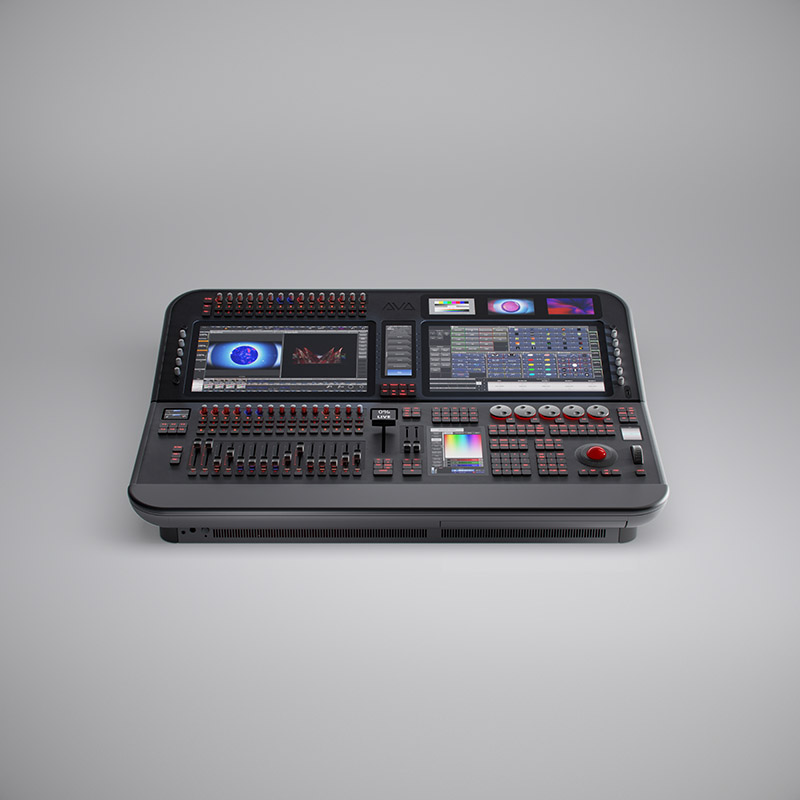
The console is offered in two models — the full sized D9-330, which has three big touchscreens and 30 faders; or the D9-215, which has one less big screen and only 15 faders. Both consoles offer the same programming features and all other options; it’s just missing one large touchscreen out of the 11 on the big model.
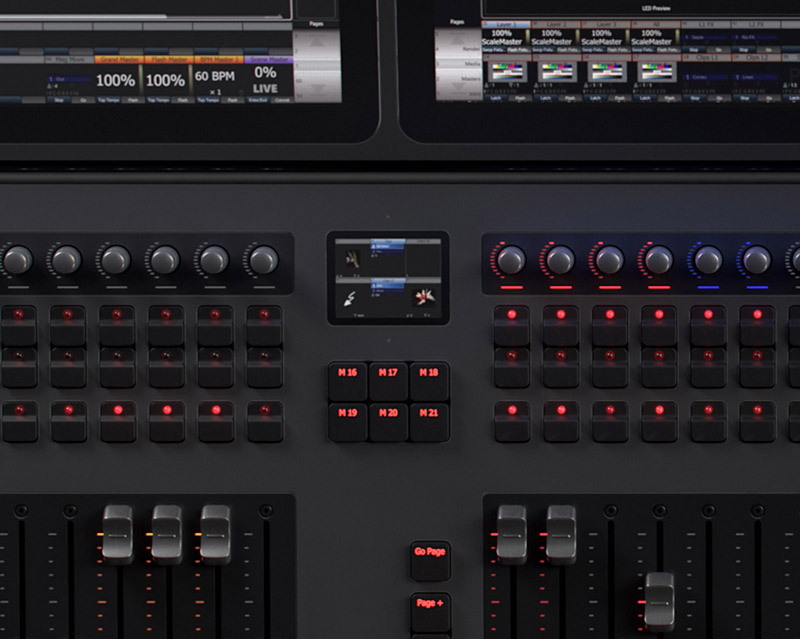
The Playback Module
The biggest feature on this desk is the number of playback cues one can access at any time. I counted 111 ways to execute a cue from a hard button or fader on one page. This includes 30 faders that feature a single assignable button at the bottom of the fader (think Flash) and another at the top (Think Execute/Go), or whatever option the user chooses. I note this is the first Avo console to feature flash buttons under the faders. The short distance clicking-type buttons utilized are what lighting consoles are meant to have.
Above the faders is another bank of buttons, similar to the add/swap buttons that one would find on an Avo desk. These are attached to a rotary encoder that fulfills the fader functions. But where I see it getting the most use is as a BPM regulator, or for adjusting the speed or amplitude of any effect easily in a live application. There is an identical set of these rotary knobs and buttons above the large monitor. The rotary knobs and faders are currently separated, but will have the option to link together in the future.
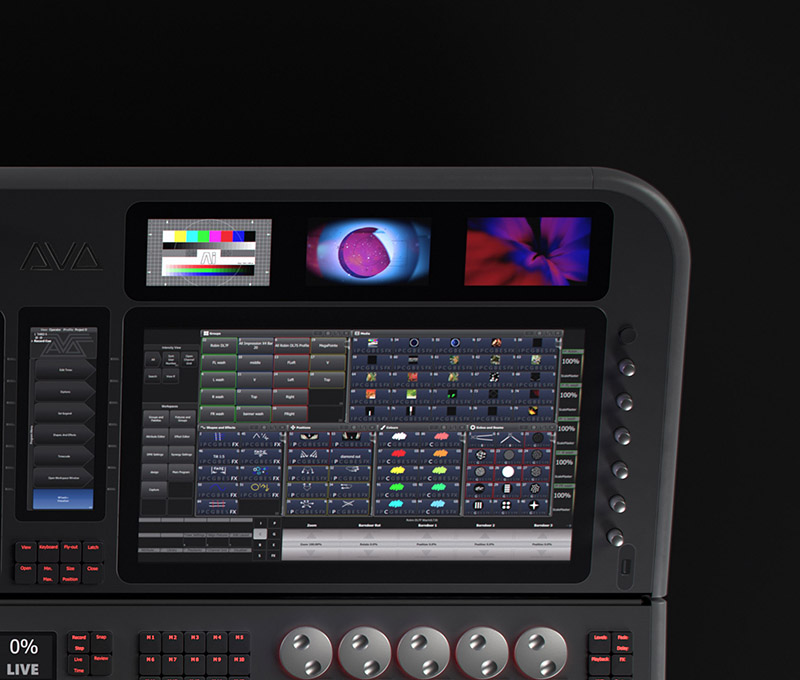
The faders and encoders come equipped with LED indicators. The colors can be user defined. The smart faders are motorized, but also touch sensitive. If you are resting your finger on a fader, the console will let you know. A highlight on the screen tells you which fader/cue your finger is resting on.
There is another set of faders on the D9-330 that is separated by some page change buttons. Each set of faders and playback buttons can run on any page at any time; users can configure it to fit their needs. There are also an additional six “macro” buttons between the faders that are user-configurable for anything.
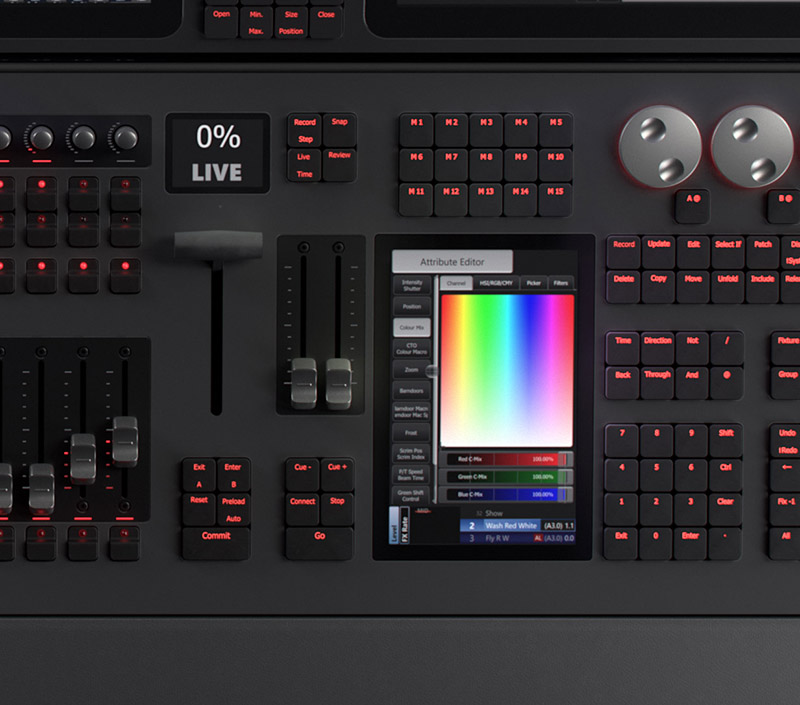
The big screens are configurable with the option of using one of them with the Capture 2020 Previz engine included. I note that the Visualizer will also work in blind mode to show you what the scene you are currently working on will look like, even though you may be sitting in another cue live.
Separating the playback and program sections is a T-Bar that is a really clever Scene Master — perfect for activating multiple live palettes at once. I simply press the “enter” button under it and it puts me in a blind mode. Then I can look at the visualizer and adjust any attributes I want. Then when I push the T-bar in the opposite direction, the changes will happen in time with my push. I simply press “Exit” to disengage the T bar. One can also use a “Go” button under the bar to activate the preset information. There’s also a small dedicated screen above the T-Bar that shows its status.
In addition are two master cue stack faders separating the program and playback section. One fader will serve as the master intensity for the selected cue stack, while the other can be either manual crossfade or FX rate. I note there are no dedicated Grand Master or DBO buttons on the desk. They can be placed on any fader or button you wish on the surface.
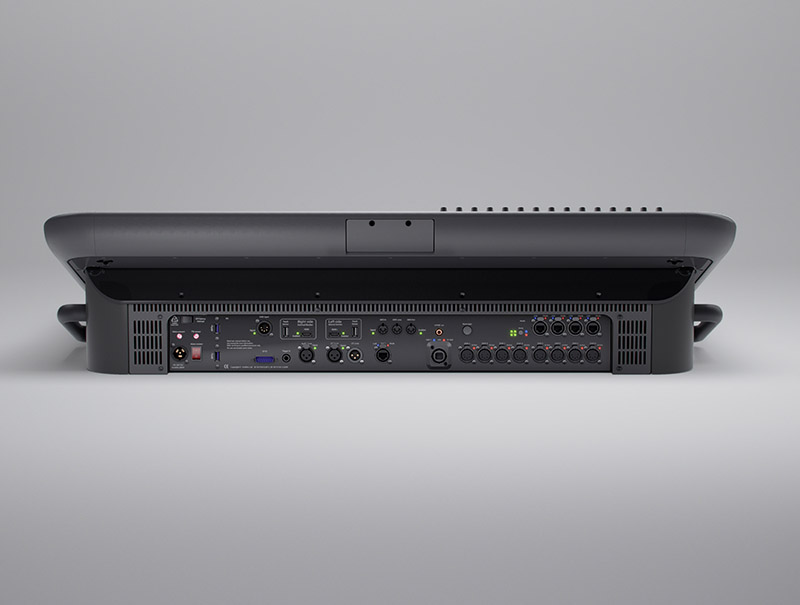
Programming
There are five single encoder wheels for scrolling through attributes. Avo opted to not have them be the push-type wheels as many users complained that pushing on the encoder often changes the value on it slightly. Instead, they have opted to place another button directly under each wheel that can change the encoder’s function or allow the user to enter a numerical value. Right below the encoder wheels, you will find the typical buttons needed to program cues, such as Copy, Delete, Update, etc., on one side and another set that dictate attributes such as Gobo, Color, Effect, etc., on another.
New to the Avo consoles is the addition of a vertical wheel for quick adjustment of dimmer values. The wheel can be assigned to be an encoder for any attribute. A very smart move by Avo was to install another small display right above the wheel that tells users the percentage they are at without having to find an output view on a monitor. There is also a button marked “@ level” for manually typing in a value.
Almost every programmer I’ve met demands a trackball for quick focusing of movers and quick access to page changes and spread sheets. It’s right where it belongs, in the lower right corner. Just off to the left of it are the typical buttons used for focusing fixtures such as Highlight and Align. As for the buttons in the programming side, they are all RGB backlit. I can feel the inaudible click as I execute a button push. The ergonomically designed caps for the buttons just feel right to my touch.
In the upper right side of the console are three small screens whose primary function is to preview video clips. They can display video from any source using NDI. One window can be set up to have the current content playing if desired, while the others can contain the next two the user may wish to play. Of course, Avolites’ AI server range utilizes NDI, so the Synergy system automatically generates NDI previews when connected, and via their Titan Net protocol recognizes all clips and can store palettes of thumbnails. Another handy feature is that the programmer can upload video files from a stick through the console to the server located backstage. If video is not utilized in a show, these screens can be used for other purposes, such as a timecode clock. Switching between video cues live with no cue stack involved is a great feature, allowing the LD to play VJ with ease.
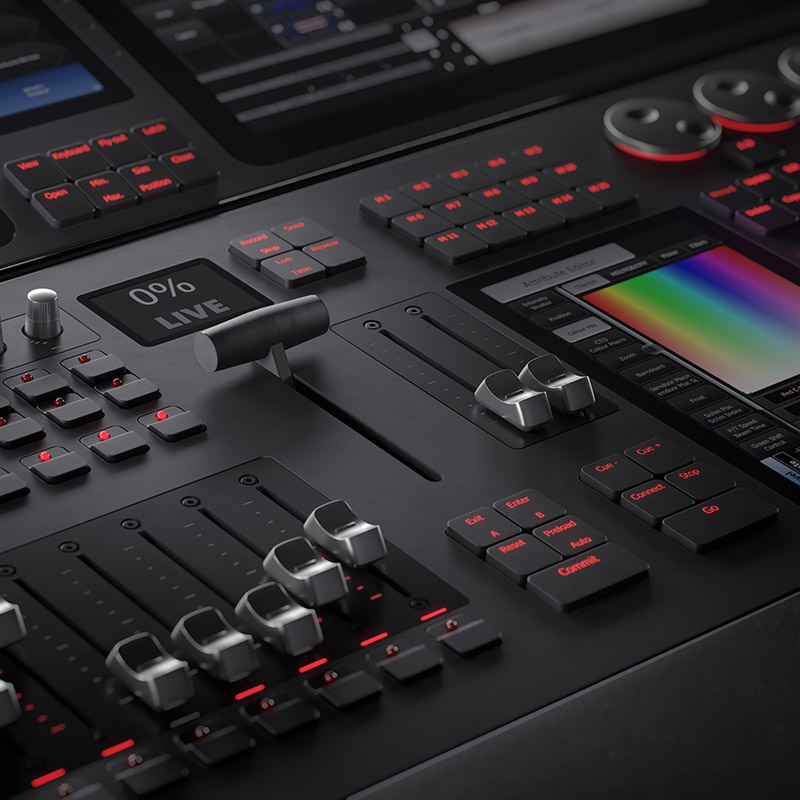
Hardware Notes
The build quality on this desk really is second to none. For example, the two panels are machined from single pieces of aluminum allowing them to be worked much more precisely and facilitating the intricate level indicators while maintaining a rock-solid feel to withstand any hard pushing on buttons or slamming faders in the execution of cues. I notice the touchscreens are all flush with the surface and enable the second I let up on the screen pressure. They are sealed from dirt.
Once again, an internal keyboard has been placed in a drawer (the buttons on the keyboard match the buttons on the programmer — hurrah!) and the arm rest pad flips up for a storage area. This space includes a USB 3 port to keep a memory stick in place. The on/off power switch is located there as well.
There’s support for up to four RBW LED gooseneck lamps for illuminating the front surface, and the dimmable screens emit 1000 NITS of brightness so one can view them in daylight easily. The console also includes some white LED strips in the front (to make viewing paperwork easy without refocusing a gooseneck), and one in the back to see all the connectors.
The console comes with eight dedicated 5-pin DMX outputs as well as an Ethernet connection that comes straight from the motherboard. Also inside is a Luminex Network Switch which is capable of VLAN Grouping and is connected to four more dedicated Ethernet outputs for sACN or Art-Net distribution. Also on board is a fiber optic connecter for one’s snake. Users can now get rid of their FOH rack and run digital Intercom directly through the console and down the fiber. The console itself can spit out 32 universes alone, but can control many more with outboard Titan net processors.
There are the usual DMX inputs, audio inputs, an input to connect a foot switch and ports to attach two external monitors. The back of the console with the big screens is meant to be adjusted in height manually, with a hydraulic system. The internal battery backup will last ten minutes in the event of a power loss at the desk.

At a Glance:
Reinventing a Legend
This desk is aimed at bigger shows and is the perfect choice for festivals. Directors can access 111 different playbacks without ever changing a page. Timeline functions and cue stack operation make the console good for all applications.
Avolites Diamond 9
PROS: Embraces the same Titan software, so no new OS to learn. Makes programming or punting video files a snap. Great feel to the buttons, incredibly bright screens for outdoor use.
CONS:None
FEATURES
- Large touchscreens, motorized faders,
- New encoders w/RGB bar graphs
- Backlit integrated keyboard
- New interface w/T-bar control, other new features
- Synergy media control integration
- 32 universes of direct DMX output; 6 Ethernet ports plus network switch to support complex productions
SPECS
D9-330:
- Three Main Touchscreens (11 in all)
- 30 Motorized Faders
- 70 Executors
D9-215:
- Two Main Touchcreens
- 15 Motorized Faders
- 30 Executors
MSRP: Contact Avolites
Manufacturer: Avolites
More Info: www.avolites.com and http://d9.avolites.com


